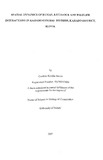| dc.description.abstract | Over the past decade in Kajiado district, there have been changes of property rights in pastoral range-lands from communal ownership, to group ownership, and recently to private ownership. The area is classified as part of the arid and semi-arid lands (ASALs) of Kenya and is home to a large numbers of wildlife and livestock. The main socio-economic activity is pastoralism, though there is a shift to other economic activities such as mining and agriculture which has led to fencing in some area and hence increased incidences of conflict between people and wildlife where wildlife depredate livestock.
Elangata Wuas group ranch is in the process of undergoing further subdivision and finally fencing of individual ranches. This process is bound to further aggravate conflict as the movement of wildlife will be curtailed by fences which will lead to personalization of forage and watering points. The main objective of this study is to establish to what extent wildlife and human utilization of habitats and various resources overlap. This was achieved by conducting total counts and using transects sampling methods along with quadrats and a pin-frame, in areas under differing grazing pressure and relating this to such variables and density of human settlement, roads and streams.
From the data, human settlement, road networks, streams, livestock and wildlife distribution were analyzed and mapped. Generally, wildlife preferred areas with low concentrations of human settlement. This was consistent with the prediction that the wildlife tends to avoid areas that are intensively used by humans and their livestock. Specific consistence of the predictions on animal distribution was shown where 12 species did not show any preference for areas used by human beings but two species; baboon and Impala, tended to aggregate close to human settlements. Gerenuk, reedbuck and wildebeest utilized area with high grass cover while zebra tended to utilize area with taller grass.
To ensure minimal conflict, in-depth studies into means to scale predator-prey ratios need to be looked into as predators are the main animal guild in conflict with people, yet direct methods of studying predators are insufficient to give good estimates of predators. The Over the past decade in Kajiado district, there have been changes of property rights in pastoral rangelands from communal ownership, to group ownership, and recently to private ownership. The area is classified as part of the arid and semi-arid lands (ASALs) of Kenya and is home to a large numbers of wildlife and livestock. The main socio-economic activity is pastoralism, though there is a shift to other economic activities such as mining and agriculture which has led to fencing in some area and hence increased incidences of conflict between people and wildlife where wildlife depredate livestock.
Elangata Wuas group ranch is in the process of undergoing further subdivision and finally fencing of individual ranches. This process is bound to further aggravate conflict as the movement of wildlife will be curtailed by fences which will lead to personalization of forage and watering points. The main objective of this study is to establish to what extent wildlife and human utilization of habitats and various resources overlap. This was achieved by conducting total counts and using transects sampling methods along with quadrats and a pin-frame, in areas under differing grazing pressure and relating this to such variables and density of human settlement, roads and streams.
From the data, human settlement, road networks, streams, livestock and wildlife distribution were analyzed and mapped. Generally, wildlife preferred areas with low concentrations of human settlement. This was consistent with the prediction that the wildlife tends to avoid areas that are intensively used by humans and their livestock. Specific consistence of the predictions on animal distribution was shown where 12 species did not show any preference for areas used by human beings but two species; baboon and Impala, tended to aggregate close to human settlements. Gerenuk, reedbuck and wildebeest utilized area with high grass cover while zebra tended to utilize area with taller grass.
To ensure minimal conflict, in-depth studies into means to scale predator-prey ratios need to be looked into as predators are the main animal guild in conflict with people, yet direct methods of studying predators are insufficient to give good estimates of predators. The
V111
wild herbivore biomass present appears to be sufficient as there are very few reported cases of depredation on livestock.
The way forward is to implement projects that endeavor to capture the link between livestock, herbivore and predators that will allow for a conclusion on the proponent of change in this environment and implementation of appropriate measures for reduction of conflict in a changing land-use setting.
Wild herbivore biomass present appears to be sufficient as there are very few reported cases of depredation on livestock.
The way forward is to implement projects that endeavor to capture the link between livestock, herbivore and predators that will allow for a conclusion on the proponent of change in this environment and implementation of appropriate measures for reduction of conflict in a changing land-use setting. | en_US |

